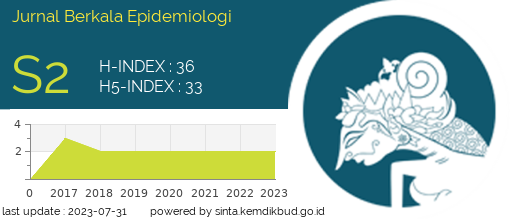Waist Circumference as The Strongest Factor Related to Blood Glucose Level
Downloads
Increased prevalence of overweight and obesity is associated with an increased incidence of type 2 Diabetes Mellitus (DM). Abdominal obesity is an important risk factor for the onset of DM. This study aims to determine the relationship between body mass index, abdominal circumference, and the ratio of hip waist circumference with blood sugar levels. The study design was cross-sectional. The study population was members of Integrated Health Posts for the elderly (Posyandu lansia) aged 45 to 70 years in the working area of the Public health center (PHC) of Menur registered in the Posyandu activities in May 2013. The number of respondents was 60 respondents taken using the simple random sampling method. The variables studied were respondent characteristics, body mass index, abdominal circumference, hip waist circumference ratio, and fasting blood sugar levels. The results showed that respondents were overweight (38%), obesity (33.3%), abdominal obesity based on abdominal circumference (77.8%), abdominal obesity based on the hip waist circumference ratio (81.7%), and blood sugar levels of125 mg/dl (8.3%). Pearson correlation test shows that body mass index has a relationship with blood sugar levels (p = 0.007; r = 0.345), abdominal circumference has a relationship with blood sugar levels (p = 0.001; r = 0.424,) and hip waist circumference ratio is related to blood sugar levels (p = 0.002;r = 0.392). The abdominal circumference has the strongest relationship with blood sugar levels. Abdominal circumference measurements should be used in elderly Posyandu activities to detect individuals at high risk of diabetes.
Bambrick, H.J. 2005. Relationships between BMI, Waist Circumference, Hypertension and Fasting Glucose: Rethinking Risk Factors in Indigenous Diabetes. Australian Indigenous Health Bulletin, 5: 4
Barasi, M.E. 2007. At a Glance Ilmu Gizi. Jakarta: Erlangga
Beck, E.M. 2000. Ilmu Gizi dan Diet Hubungannya dengan Penyakit-Penyakit untuk Perawat dan Dokter. Yogyakarta: Andi
Bloemhoff. 2010. Gender and Race Related Physical Activity Levels of South African University Students. African Journal for Physical, Health Education, Recreation and Dance. ISSN: 1117-4315
Bustan, 2007. Epidemiologi: Penyakit Tidak Menular. Jakarta: Rineka Cipta
Depkes. 2008. Riset Kesehatan Dasar (RISKESDAS) 2007. Jakarta: Departemen Kesehatan RI.
Fahmida, U dan Drupadi H. 2007. Handbook Nutritional Assessment. Jakarta: The Ministry of National Education, Republic of Indonesia
Farag, Y Mahmoud R, 2011. Diabesity: An Overview of a Rising Epidemic. Nephrol Dial Transplant, 26: 28–35
Fatmah. 2010. Gizi Usia Lanjut. Jakarta: Erlangga Frank, B. 2008. Obesity Epidemiologi. New York: Oxford University Press
Gibney MJ, Margetts BM, Kearney JM, Arab L. 2008. Gizi Kesehatan Masyarakat (Public Health Nutrition). Diterjemahkan olah Hartono. Jakarta: Penerbit Buku Kedokteran EGC.
Guyton, A.C. 1994. Buku Ajar Fisiologi Kedokteran. Jakarta: Buku Kedokteran EGC.
Hardiman, S, Intan Nevita Bernanthus, Puspa K Rustati, Eva Susiyanti. 2009. Waist circumference as a predictor for blood glucose levels in adults. Universa Medicina. Vol.28 - No.2
Hartini, S. 2009. Diabetes? Siapa Takut Panduan Lengkap untuk Diabetisi, Keluarganya, dan Professional Medis. Bandung: Qonita PT Mizan Pustaka.
Hartono, A. 2004. Terapi Gizi dan Diet Rumah Sakit. Buku Kedokteran EGC: Jakarta
Hidayatulloh, A., 2011. Hubungan Faktor Risiko Obesitas dengan Rasio Lingkar pinggang Pinggul Mahasiswa FKM UI. Berkala Ilmiah Mahasiswa gizi Indonesia. vol 1 no 1
Siren, R. Eriksson, Johan G, V. Hannu. 2012. Disease Waist Circumference A Good Indicator of Future Risk for Type 2 Diabetes and Cardiovascular. BMC Public Health. 12:631
Patil, S.P dan S. B, Archana. 2012. Correlation of Blood Sugar with Waist Circumference and Body Mass Index in an Indian Population. Global J. Pharmacol., 6 (1)
Soegih, R, dan K. wiramihardja. 2009. Obesitas Permasalahan Dan Terapi Praktis. Jakarta: Sagung seto
Soegondo, S. 2008. Hidup Secara Mandiri Dengan Diabetes Melitus, Kencing Manis, Sakit Gula. Jakarta: Fakultas Kedokteran Universitas Indonesia
Soetiarto, F dan R. Suhardi. 2010. Hubungan Indeks Massa Tubuh Dan Lingkar Pinggang Data
Riskesdas 2007. Buletin Penelitian Kesehatan Vol. 38, No. 1,2010: 36 -42
Sulistyaningrum, 2010. Hubungan Indeks Massa Tubuh Dan Rasio Lingkar Pinggang Pinggul Dengan Kadar Gula Darah Puasa. Skripsi. Semarang Universitas Negeri sebelas Maret.
Tandra, H. 2008. Segala Sesuatu yang Harus Anda Ketahui tentang Diabetes: Panduan Lengkap Mengenal dan Mengatasi Diabetes dengan Cepat dan Mudah. Jakarta: Gramedia Pustaka Uama
Wang, Y, E.B. Rimm, M.J., Stampfer, W. Willett dan Frank B hu. 2005 Comparison of Abdominal Adiposity and Overall Obesity in Predicting Risk ff Tipe 2 Diabetes Among Men. The American jurnal of clinical nutrition.;81:555-563
- Every manuscript submitted to must observe the policy and terms set by the Jurnal Berkala Epidemiologi
- Publication rights to manuscript content published by the Jurnal Berkala Epidemiologi is owned by the journal with the consent and approval of the author(s) concerned. (download copyright agreement)
- Complete texts of electronically published manuscripts can be accessed free of charge if used for educational and research purposes according to copyright regulations.

JBE by Universitas Airlangga is licensed under a Creative Commons Attribution-ShareAlike 4.0 International License.























